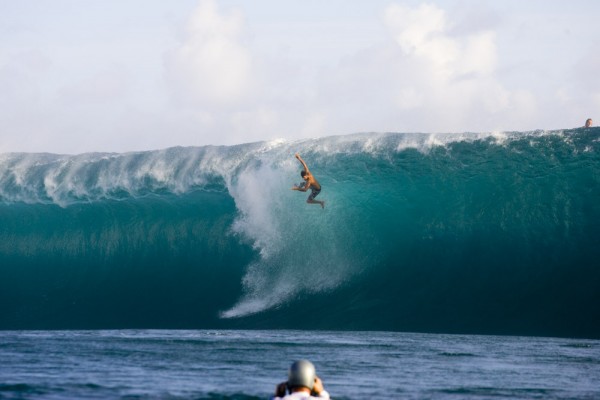The Top 10 Deadliest Waves
PEACEANDSURF takes you on a harrowing ride around the world in search of the world’s deadliest waves… —By Justin Cote and Ryan Browe
Banzai Pipeline
Located on the North Shore of Oahu, Pipeline is undoubtedly the heaviest and most deadly wave in the world. Hollow and powerful lefts and rights (Backdoor) break just off the beach over a jagged coral reef.Over the years, Pipeline has tragically taken the lives of more spots than anywhere else combined, including local bodyboarder Joshua Nakata this past March, renowned water photographer Jon Mozo in February 2005, Tahitian pro surfer Malik Joyeux in December 2005, aspiring Japanese pro surfer Moto Watanabe in January 2004, and experienced Puerto Rican surfer Joaquin Velilla in January 2007. The list of casualties goes on…
Unidentified getting lip-launched at Pipeline. Photo: Brian Bielmann
Ghost Trees
Located off the coast of Pebble Beach in Northern California, Ghost Trees is colder and more shark-infested (great whites to boot) than most breaks in the world. Add in the huge boulders that line the shore and bottom and you’ve got yourself California’s heaviest wave.Alistair Craft at Ghost Trees. Photo: Nelly
Mavericks
NorCal local Ben Andrews at Mavericks. Photo: Jack English
Teahupoo
Regarded as one of the most challenging surf breaks in the world, Teahupoo is located on the southwest tip of Tahiti—the main island of the French Polynesian archipelago. The top-heavy left breaks a half-mile out to sea and mere feet over a living, razor-sharp coral reef.
Even the best pay the price at Teahupoo. Bruce Irons. Photo: Jones
Waimea
Bruce Irons at Waimea. Photo: Checkwood
With the combination of neck-breaking shorebreak and wave faces that can reach up to sixty feet, Waimea has seen its share of tragedy and claimed the life of Dickie Cross in 1943 and aspiring California pro surfer Donnie Solomon in 1999. Legendary Kauai waterman Titus Kinimaka also had his femur snapped in half after a particularly nasty wipeout back in 1989. Said Hawaiian pro surfer/esteemed shaper Dennis Pang of Waimea wipeouts: “At Pipeline, it’s white when you’re underwater, and at Sunset it’s gray. Waimea is black.”
Shipstern Bluff
If there’s one wave that could possibly mirror the shape of Teahupoo, it would be Shipstern Bluff, located off the south end of the island of Tasmania. Access to “Shippies” is via a two-hour hike around Tasman National Park, or a long and bumpy boat ride from the nearby harbor.
Australian hell-charger Laurie Towner tackles Shipstern Bluff. Photo: Jones
The bottom at Shipstern is a slab of granite that takes the brunt of huge swells traveling from deep water and expounding all their force onto this ledge. It also breaks right in front of a boulder-piled headland, adding even more risk to the already impossible drop. Add in the fact that you’ll need to be wearing a 4/3 wetsuit and booties almost year round here, and one can easily see why it’s only ridden by the most demented of chargers.
Dungeons
Mark Healey air drops into oblivion at Dungeons. Photo courtesy Red Bull BWA
With this heightened risk at Dungeons, also know that it’s got frigid water, gigantic underwater boulders, and hold-downs that can be longer than anywhere in the world. Considering it got its name from a local who was held under for two consecutive 25 footers, it’s easy to see why this right-hander has been the site for Red Bull’s Big Wave event since 2000. Plus it’s only accessible by boat, so you’d have better be one of the top ski teams in the world when you head to Dungeons.
Cyclops
Duck dive at Cyclops? Fat chance. Photo: Scott
Ours
In New South Wales, Australia lies a break so carnal that even Pancho Sullivan was once said to want nothing to do with it. Located in the Kurnell National Park, Ours is a hollow, fast, powerful right-hander that breaks in front of a large cliff face. Even if you make the drop, which you probably won’t, then you’ve got to race through a barrel that wants to tear you limb from limb, and if you don’t make it you get pinned up against that cliff face we mentioned. This is also a favorite spot of the famed Bra Boys, so when they’re out, which is when it’s firing, you don’t want any part of it. If the waves don’t kill you, the locals might.
Ours. Photo: Jones
New Smyrna
Compared to the other waves on this list, New Smyrna is a creampuff in terms of sheer force, even though it does offer some of the best surf in Florida. When there’s swell, this can be one of the top spots in the Sunshine State, but the other side of this is everyone else knows this too.
New Smyrna local. Photo: Dorsey
Located on the south side of the murky waters of Ponce Inlet, New Smyrna also has some world-class fishing, which means sharks aren’t far away either. And when the majority of the attacks are from Bull sharks, some of the most feared sharks in the world, you are pretty much putting things on the line when you surf New Smyrna.
Think we’re full of it? Add your “Top 10 Deadliest Waves” in the User Comments box below!
16:10
|
Libellés :
Peace&Surf,
Photography,
top 10
|
This entry was posted on 16:10
and is filed under
Peace&Surf
,
Photography
,
top 10
.
You can follow any responses to this entry through
the RSS 2.0 feed.
You can leave a response,
or trackback from your own site.
Inscription à :
Publier les commentaires (Atom)











0 commentaires:
Enregistrer un commentaire